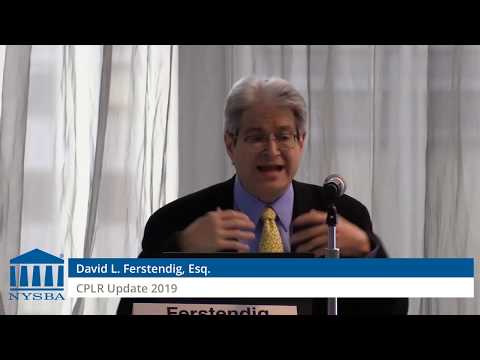
Welcome to this comprehensive guide on Understanding the CPLR Statute: New York’s Civil Practice Law and Rules. In this informative article, we will delve into the intricacies of this important statute, shedding light on its purpose, key provisions, and practical implications. It is important to note that while we strive to provide accurate and up-to-date information, it is always advisable to cross-reference with other reliable sources or consult with legal professionals for specific advice.
Now, let’s embark on our journey to explore the CPLR Statute and gain a deeper understanding of its significance in New York’s legal landscape.
Understanding the CPLR Statute in New York: A Comprehensive Guide
Understanding the CPLR Statute: A Comprehensive Guide to New York’s Civil Practice Law and Rules
📋 Content in this article
The Civil Practice Law and Rules (CPLR) is a statute that governs civil litigation in the state of New York. It provides a comprehensive framework for the procedures and rules that must be followed in civil cases filed in New York’s courts. Understanding the CPLR is essential for anyone involved in or contemplating a civil lawsuit in the state.
To help you navigate through this complex statute, we have prepared this comprehensive guide. Here, we will provide an overview of the CPLR and its key provisions, explain the importance of understanding these rules, and highlight some of the essential aspects that you should be aware of.
The CPLR is a set of rules that governs civil litigation in New York. It covers various aspects of civil practice, including the commencement of lawsuits, pleadings, discovery, motion practice, trial procedure, and appeals. The statute is organized into articles and sections, each addressing specific topics within civil litigation.
Understanding the CPLR is crucial for anyone involved in a civil lawsuit in New York. It ensures that all parties are aware of their rights and obligations and that they follow the proper procedures throughout the litigation process. Compliance with the CPLR is essential to avoid procedural errors that could potentially harm your case.
1. Commencement of Lawsuits: The CPLR sets forth the requirements for initiating a lawsuit, including proper service of process, filing deadlines, and the contents of a summons and complaint.
2. Pleadings: The CPLR governs the types of pleadings that may be filed, such as complaints, answers, and counterclaims.
Understanding the Timeframe to Respond to CPLR 320 in US Law
Understanding the Timeframe to Respond to CPLR 320 in US Law: A Comprehensive Guide to New York’s Civil Practice Law and Rules
Introduction:
In the legal system of the United States, it is crucial to understand the time frames within which certain actions must be taken. One such important time frame is the deadline to respond to a CPLR 320 notice. CPLR stands for Civil Practice Law and Rules, and CPLR 320 specifically pertains to the timeframe for responding to a notice. This guide aims to provide a comprehensive understanding of CPLR 320 and its significance in New York’s legal system.
1. What is CPLR 320?
CPLR 320 is a section of New York’s Civil Practice Law and Rules that governs the timeframe within which a party must respond to a notice. This notice is usually served in connection with an action brought in a New York court, and it serves as a formal notification to the recipient that they are being sued.
2. Time Frame for Responding:
According to CPLR 320, the recipient of a notice has twenty (20) days to respond after being served with the notice. This timeframe is crucial, as failing to respond within the stipulated period can have severe consequences and may result in a default judgment being entered against the recipient.
3. Methods of Service:
In order for the time frame under CPLR 320 to begin running, the notice must be properly served on the recipient. Proper service means that the notice must be delivered in accordance with the legal requirements set forth in New York law. The most common methods of service include:
Understanding the CPLR Statute: A Comprehensive Guide to New York’s Civil Practice Law and Rules
Introduction:
The Civil Practice Law and Rules (CPLR) is a vital component of the legal framework in the state of New York. It governs civil litigation procedures, providing a set of rules and guidelines that ensure fairness and efficiency in the resolution of legal disputes. As a legal professional, it is crucial to stay current on the CPLR statute to effectively navigate the complexities of the New York legal system.
Importance of Staying Current:
1. Compliance with Legal Procedures:
Staying up-to-date with the CPLR statute is essential for legal professionals to ensure they are compliant with the proper legal procedures. Failure to adhere to the rules set forth by the CPLR can lead to delays, dismissal of cases, and even sanctions.
2. Effective Case Management:
Knowledge of the CPLR statute allows attorneys to effectively manage their cases. By understanding the rules surrounding pleadings, discovery, motions, and trial procedures, attorneys can develop a strategic approach to their cases and present their arguments in the most effective manner possible.
3. Preserving Client Rights:
Keeping abreast of developments in the CPLR statute is crucial for protecting and preserving client rights. Changes or amendments to the law can impact a client’s ability to bring a claim or defend against one. By staying current, attorneys can provide accurate advice to their clients and ensure their rights are safeguarded.
4. Efficient Resolution of Disputes:
The CPLR statute is designed to promote efficient resolution of disputes. By staying current on the rules and procedures, attorneys can navigate the legal system more effectively, reducing unnecessary delays and costs for their clients.
Tips for Staying Current:
1. Regularly Review CPLR Updates:
To stay current on the CPLR statute, it is essential to regularly review updates and amendments issued by relevant authorities. These updates may include changes to the rules, new case law interpretations, and revisions to local court rules.
